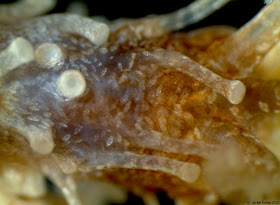I'll show you another example. And I'll also reveal that these are under extreme magnification (viewed under a compound microscope). [Beth — are you jumping up and down with a guess yet?]
To help even more, I'll zoom out, and show a little more of this animal.
This may be difficult, so the next image is the entire animal. (Yes, be forewarned, the answer is below.)
This is a sea cucumber (Cucumaria pseudocurata) that lives in the mussel beds along our local rocky shores. This species is small; most individuals are less than 3.5 cm long, and many of the ones we encounter are only 1-2 cm long.
The skeleton in sea cucumbers has been reduced to small perforated plates called ossicles. That's what was featured in the first and second photos of this post.
Under less extreme magnification, the ossicles look like small, leaf-like shiny plates. They're visible in the sea cucumber's tubefeet (third photo of this post) and in the body wall (next image).
Sea cucumbers are holothuroids, one of five extant classes of echinoderms (they're related to sea stars, sea urchins, brittle stars, and crinoids —
more about those other groups soon!). Holothuroid means "in the form of a zoophyte." A zoophyte is an animal that resembles a plant (zoo = animal; phyte = plant).
So how does a sea cucumber look like a plant? I'm actually not sure about this, but my guess is that it might be related to the shape of the specialized feeding tentacles. Here's a view of one tentacle:
You can see how this tentacle (actually a modified tubefoot) is branched and tree-like. (And note that it also has ossicles.) The branches increase the surface area for feeding. The sea cucumber captures phytoplankton and diatoms from the water and nearby surfaces and then sweeps the food particles to the mouth at the center of the tentacles. In the image below, the mouth is a small raised bump in the middle of the ten tentacles.
Although hidden from view most of the time, deep within the mussel beds, these small sea cucumbers are fascinating members of the rocky shore community. Think of them and their shiny ossicles and tree-like tentacles the next time you're next to a patch of mussels!







ahhhahahaha! Love it - thanks for the shout out - amazing images! great guessing game!
ReplyDeleteI must admit - I only got it when I saw the full individual . . .
Me too. Do all sea cucumbers eviscerate in self defense? Even these little guys?
ReplyDeleteGood question, Claudia! I'm guessing that not *all* sea cucumbers eviscerate, at least not readily. However, there may be a tricky line between do they eviscerate and can they eviscerate, but I'll have to do more research and get back to you. We've handled quite a few individuals of this species over the years, and haven't seen them eviscerate yet...but we're also pretty careful with them. More soon!
ReplyDelete